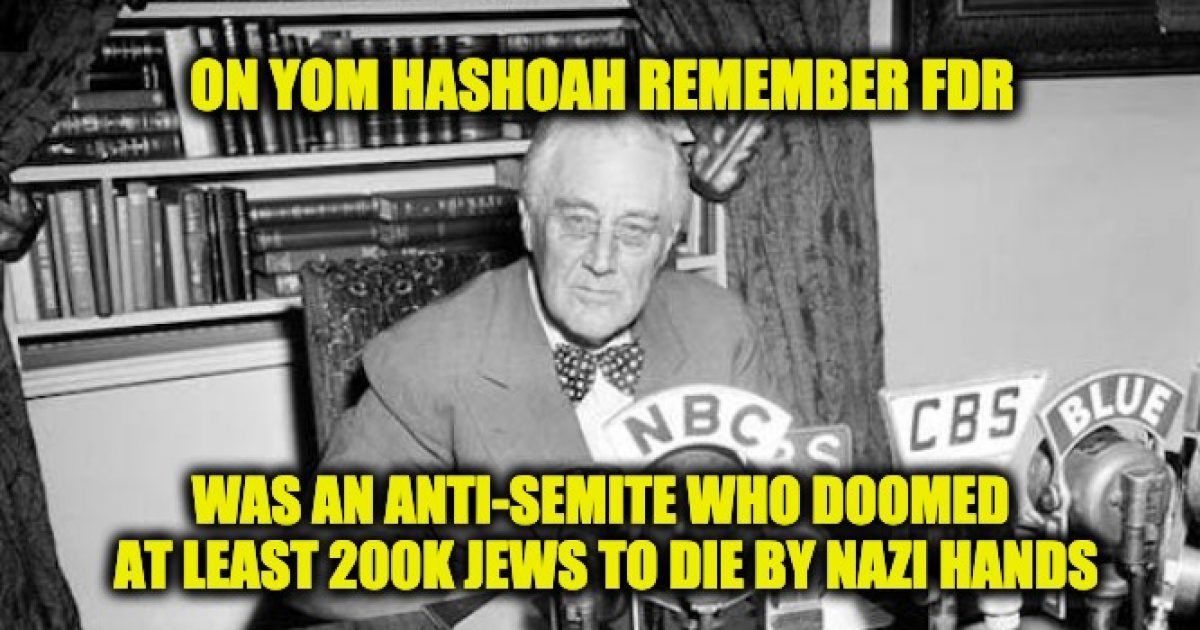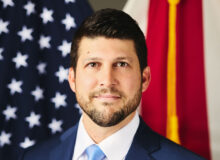Will this presidential election be the most important in American history?
Monday night April 20th begins Yom HaShoah a worldwide day of remembrance for the approximately six million Jews who perished in the Holocaust as a result of the actions carried out by Nazi Germany and its allies. One of the relatively unknown things about the Holocaust was FDR’s contribution to Jewish deaths. FDR hated Jews and refused to allow them to come to the U.S. FDR’s Jew hatred
I’ve never understood the reverence for Franklin Delano Roosevelt. He gets points for picking great Generals and led this country to victory in WWII. But he totally mismanaged the economy, making the great depression longer…in 1937 unemployment spiked again reaching 19% (the previous high was 25%), his freedom-sapping policies never did get this country out of the Great Depression, and don’t forget that he tried to circumvent constitutional separation of powers (now who does that remind me of?). And then there is the issue never discussed, he was a bigot, he threw Japanese-Americans in camps, and his hatred of Jews caused hundreds of thousands to be added to the ranks of Hitler’s victims. FDR’s Jew hatred
Typically, when one asks a Democrat about FDR, they immediately develop a sense of awe that reminds me of those little green aliens (undocumented spacemen?) in Toy Story every time they see Buzz Lightyear.” AHHHHH!”
Winston Churchill’s appeasement of the Palestinian Arabs doomed tens of thousands more.
Some point to the fact he didn’t he bomb and destroy the train tracks that were shipping Jews to the concentration camps? But I side with the people who say that wouldn’t have worked. The real question to be explored was why didn’t allow more Jews into the country and why didn’t he pressure Britain to allow Jews to move from Nazi-controlled areas into what was then called Palestine? And his plan for the Jews after the war (called Project M) was thinly spread the remains of European Jewry throughout the world so they couldn’t do damage or incite hatred.
In the book “FDR and the Holocaust: A Breach of Faith,” historian Rafael Medoff suggests that Roosevelt failed to take relatively simple measures that would have saved significant numbers of Jews during the Holocaust because his vision for America was one that had a small amount of Jews. In other words, FDR doomed many Jew to suffer not because he wanted them to die, but because he didn’t want a lot of them living in his neighborhood. FDR’s Jew hatred
In a piece for the Brandies Center, Medoff shared some of the hateful/public anti-Semitic statements Roosevelt made when he let his guard down:
In 1923, as a member of the Harvard board of directors, Roosevelt decided there were too many Jewish students at the college and helped institute a quota to limit the number admitted. In 1941, he remarked at a Cabinet meeting that there were too many Jews among federal employees in Oregon.
In 1938, he privately suggested that Jews in Poland were dominating the economy and were therefore to blame for provoking anti-Semitism there. In 1941, he remarked at a Cabinet meeting that there were too many Jews among federal employees in Oregon. In 1943, he told government officials in Allied-liberated North Africa that the number of local Jews in various professions “should be definitely limited” so as to “eliminate the specific and understandable complaints which the Germans bore towards the Jews in Germany.”
In 1936, he characterized a tax maneuver by the publisher of the New York Times as “a dirty Jewish trick.” In 1938, FDR privately suggested to Rabbi Stephen S. Wise, the era’s most prominent American Jewish leader, that Jews in Poland were dominating the economy and were to blame for provoking antisemitism there. In 1939, Roosevelt expressed (to a U.S. senator) his pride that “there is no Jewish blood in our veins.” In 1940, he dismissed pleas for Jewish refugees as “Jewish wailing” and “sob stuff.” I
The most detailed of FDR’s statements about Jews was made during his meeting on January 17, 1943, in Casablanca, with leaders of the new local regime in Allied-liberated North Africa. U.S. ambassador Robert Murphy remarked that the 330,000 Jews in North Africa were “very much disappointed that ‘the war for liberation’ had not immediately resulted in their being given their complete freedom.”
(Before the war, when the Jews lived under the colonial French regime, they enjoyed rights similar to French citizens. But when the pro-Nazi Vichy French took over the French colonies in 1940, they stripped Jews of those rights. In 1943, upon the defeat of the Vichyites, the Jews had expected their rights would be restored.)
According to the official record of the conversation (later published by the U.S. government in its ‘Foreign Relations of the United States’ series), the president replied that “the number of Jews engaged in the practice of the professions (law, medicine, etc) should be definitely limited to the percentage that the Jewish population in North Africa bears to the whole of the North African population,” which “would not permit them to overcrowd the professions.”
FDR explained that his plan “would further eliminate the specific and understandable complaints which the Germans bore towards the Jews in Germany, namely, that while they represented a small part of the population, over fifty percent of the lawyers, doctors, school teachers, college professors, etc, in Germany, were Jews.” (It is not clear where FDR obtained those wildly inflated statistics.)
Perhaps his distaste for Jews was the reason, that while there were many actions FDR could have taken to stop or slow down the Holocaust, he didn’t. “He could have quietly permitted the immigration quotas to be filled to their legal limit — that alone would have saved 190,000 lives,” Medoff said.
“He could have pressed the British to open Palestine’s doors to Jewish refugees. He could have authorized the use of empty troop-supply ships to bring refugees to stay in the U.S. temporarily, until the end of the war. He could have permitted refugees to stay as tourists in a U.S. territory, such as the Virgin Islands, until it was safe for them to return to Europe. He could have authorized the bombing of Auschwitz or the railway lines leading to it, which would have interrupted the mass-murder process.”
Additionally, FDR was reluctant to speak out against the impending genocide
On August 25, First Lady Eleanor Roosevelt brought her friend Alice Hamilton, who had recently spent three months in Germany, to Hyde Park to give FDR a detailed eyewitness account of German brutality against the Jews. He still refused to publicly criticize Hitler.
One of Roosevelt’s most blatant acts of bigotry involved the St. Louis:
On May 13, 1939, the St. Louis set sail from Hamburg, Germany, to Cuba with 937 Jewish refugees on board. Captain Gustav Schroder, a non-Jewish German, was determined to rescue these men, women and children from Nazi Germany. To his dismay, he was forced to return 907 passengers to Europe, landing in Antwerp, Belgium, on June 17, 1939.
Four months before Hitler invaded Poland, officially starting World War II, Jews were fleeing Germany by the thousands. Captain Schroder agreed to take a shipload on his luxury cruise liner to Cuba. Shortly before leaving, he was informed Cuba rejected most of the visas issued to his passengers. He left with them anyway, praying for a miracle.
(…) Upon arrival at Cuba, the St. Louis was not allowed to dock. Captain Schroder worked for a week in vain to allow his passengers to disembark. He was denied. Only 22 Jewish refugees were allowed entry as they did have acceptable passage, along with four Spanish citizens and two Cuban nationals. One gentleman, so distraught over returning to Nazi Germany, attempted suicide. He was taken to a hospital in Havana for treatment for his wounds.
Captain Schroder turned to America, pleading to President Franklin D. Roosevelt for help. Claims of improper paperwork, German Jewish immigration quotas and national security were given as excuses for rejecting the passengers. Afraid Schroder would run his ship ashore in Florida, forcing America to accept the refugees, the Coast Guard was sent to watch the St. Louis as it sailed close to our shores.
Finding no help anywhere in North America, Schroder was forced to return to Europe. Determined to be the liberator of his remaining 907 passengers (as one person died during the voyage), Schroder refused to return his ship to Germany until all the refugees were given protection in other countries. The United States finally stepped in and helped secure those arrangements in European countries.
Once those agreements for asylum were made, Captain Schroder docked his boat in Antwerp, Belgium, on June 17th. The United Kingdom accepted 288 passengers while France welcomed 224, Belgium accepted 214, and the Netherlands received 181. In less than a year, Hitler invaded Belgium and France in May of 1940, again threatening those refugees who for a moment had a taste of true freedom. It is estimated that 254 of the 907 returned to Europe were victims of the Holocaust, loosing their lives in concentration or internment camps.
In 2018, the Holocaust Museum released documents revealing “Project M, ” which was Roosevelt’s plan to thinly spread remains of European Jewry throughout the world (the plan can be read here) It wasn’t that Roosevelt didn’t know the best place to settle the Jewish refugees, he just didn’t want them in the United States. And he wanted his idea for dispersing Jews, “Project M” to remain secret:
FDR found time on the afternoon of July 30, 1942, in the midst of a schedule packed with meetings with Soviet Ambassador Maxim Litvinov, Secretary of State Cordell Hull, and General ‘Hap’ Arnold, to dictate a memo greenlighting the M Project. The memo, delivered by White House courier to Carter in his office in the National Press Building, a few blocks from the White House, stated: “I know that you and Henry Field can carry out this project unofficially, exploratorially, ethnologically, racially, admixturally, miscegenationally, confidentially and, above all, budgetarily.” It concluded: “Any person connected herewith whose name appears in the public print will suffer guillotinally.” Roosevelt repeatedly admonished Carter to keep the M Project completely secret.
Eugenics specifically as applied to Jews seems to be FDR’s motivation for “Project M.” He asked John Franklin Carter, who ran an informal secret intelligence service for the POTUS to help him set up the project:
Roosevelt’s first choice to head the M Project was Aleš Hrdlička, curator of physical anthropology at the Smithsonian Museum of Natural History. The two men had carried on a lively correspondence for over a decade and the President had absorbed the scientist’s theories about racial mixtures and eugenics. Roosevelt, the scion of two families that considered themselves American aristocrats, was especially attracted to Hrdlička’s notions of human racial “stock.”
But Hrdlička wouldn’t take the job because he wasn’t given full control of the project: FDR’s Jew hatred
Isaiah Bowman, president of Johns Hopkins University and a geographer, was promoted from his role as a member of the committee to the head of the project. Roosevelt knew Bowman well and so was presumably aware of his anti-Semitic views:
In 1939, Bowman fired Jewish faculty member Eric Goldman because he claimed, “There are already too many Jews at Hopkins.” Goldman had received a unanimous departmental vote for reappointment to his position as a professor of history. Bowman also speculated that “Jews don’t come to Hopkins to make the world better or anything like that. They came for two things: to make money and to marry non-Jewish women.”
In 1942, Bowman instituted a quota on the number of Jewish students admitted to the University and restricted the number of Jewish students allowed to pursue degrees in the fields of science and math. The quota was abolished in the 1950s. In addition to his anti-Semitic beliefs, Bowman also expressed anti-black and homophobic sentiments
Bowman knew precisely what Roosevelt wanted out of Project M. Four years earlier, in 1938 he did a research project for the President, examining the prospects for European settlement in South America. In setting up the 1938 plan, FDR wrote Bowman:
“Frankly, what I am rather looking for is the possibility of uninhabited or sparsely inhabited good agricultural lands to which Jewish colonies might be sent.” Roosevelt added that “such colonies need not be large but, in all probability, should be large enough for mutual cooperation and assistance—say fifty to one hundred thousand people in a given area.”
The goal of project M was very similar
Describing the M Project to UK Prime Minister Winston Churchill in 1943, Roosevelt said the study is focused on “the problem of working out the best way to settle the Jewish question,” adding that the solution “essentially is to spread the Jews thin all over the world,” rather than allow them amass in large numbers in one specific place. The conversation was recorded in the diary of Vice President Henry Wallace, who was present at the meeting.
While other modern presidents may have been bigoted, none acted on their bigotry as much as FDR (Woodrow Wilson and Barack Obama fight for #2). Liberals will claim that FDR had many Jews in his cabinet which is true, but it doesn’t mitigate his bigoted actions.
On Yom HaShoah, we commemorate the six million Jews who died at the hands of the Nazis. But their story wouldn’t be complete if we ignored the fact that the US President who worked to defeat the Nazis, contributed to their attempted extermination of the Jewish people.
FDR’s Jew hatred
FDR’s Jew hatred
FDR’s Jew hatred








